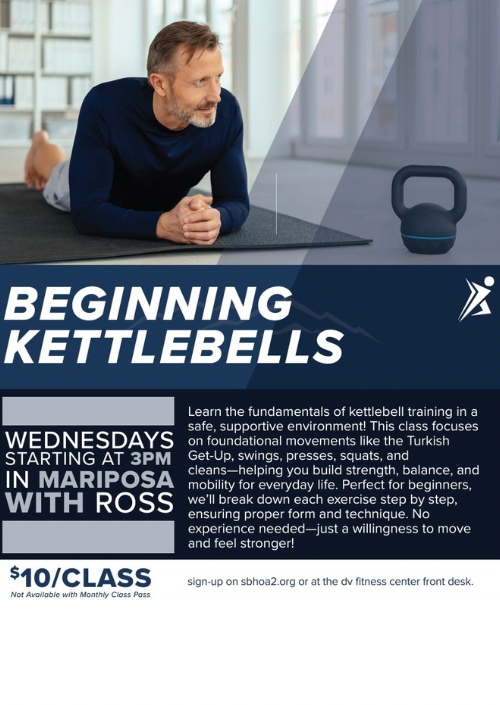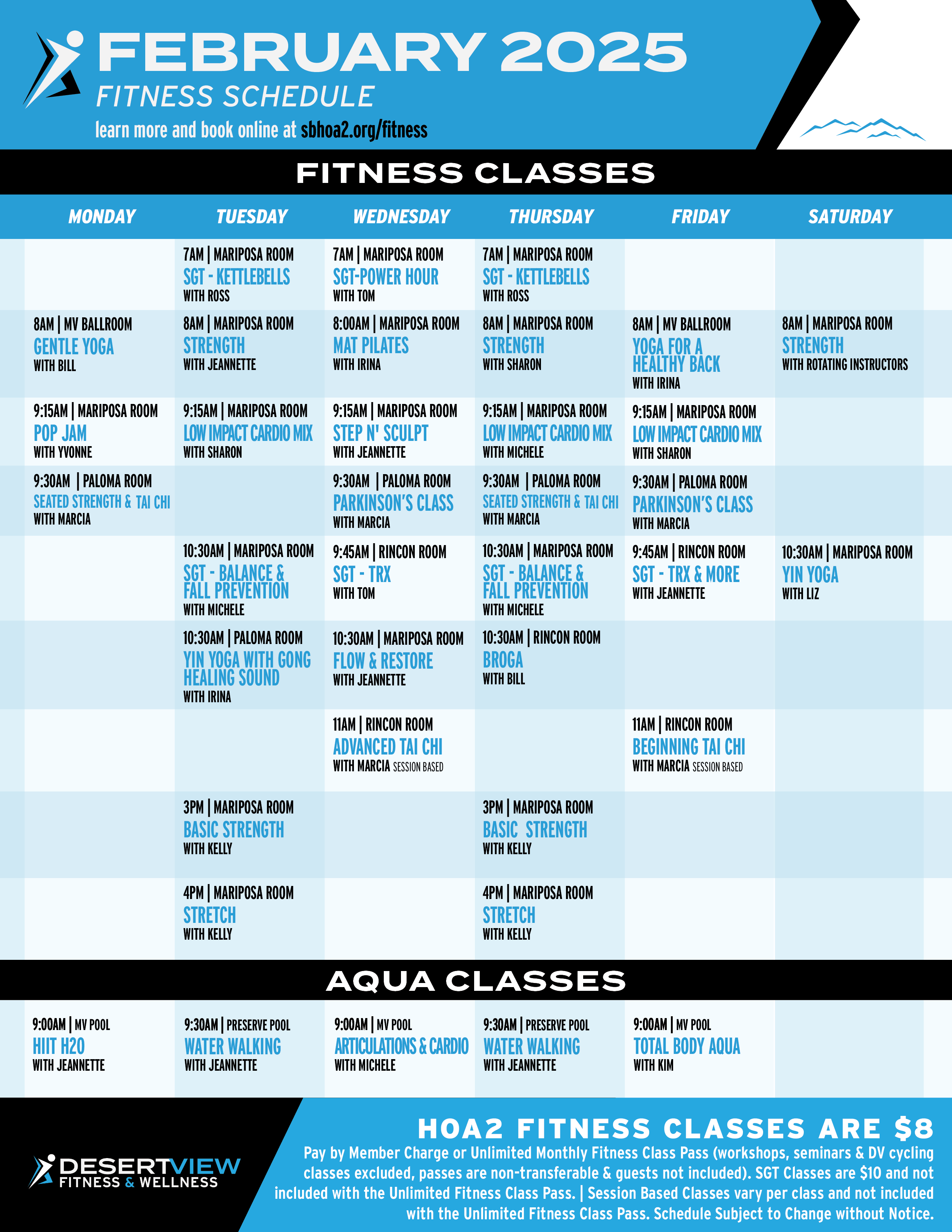DesertView Fitness & Wellness
Information below up to date as of 2/17/25
DVFitness Updates
-
SGT – TRX is Back! Join TRX Class on Wednesdays and Fridays at 9:45am.
-
The TRX suspension system is a great way to get a strength workout in without impact. Classes are $10 and are not eligible for use with the Monthly Class Pass. For more information, contact Jeannette Pyle @ [email protected].
LEARN MORE
-
The TRX suspension system is a great way to get a strength workout in without impact. Classes are $10 and are not eligible for use with the Monthly Class Pass. For more information, contact Jeannette Pyle @ [email protected].
-
Seated Strength and Tai Chi now offered on two days!
-
This class includes a combination of resistance training, using weights, bands, balls, and mild stretching. Class concludes with a series of seated Tai Chi moves that will help tone your body while obtaining a calm and tranquil mind. The deep breathing techniques used in your Tai Chi moves will also lower blood pressure and leave you feeling relaxed and calm. 9:45am on Mondays now and Thursdays beginning in February. Classes are $8 and are eligible for use with the Monthly Class Pass.
LEARN MORE
-
This class includes a combination of resistance training, using weights, bands, balls, and mild stretching. Class concludes with a series of seated Tai Chi moves that will help tone your body while obtaining a calm and tranquil mind. The deep breathing techniques used in your Tai Chi moves will also lower blood pressure and leave you feeling relaxed and calm. 9:45am on Mondays now and Thursdays beginning in February. Classes are $8 and are eligible for use with the Monthly Class Pass.
- Learn to Meditate coming in March!
- Meditation is a conscious state of mind that has focus. You will learn breathing techniques to connect mind and body, how to build a supportive posture for comfort in seated meditation, and systematic relaxation techniques to achieve a focused state of awareness with many proven health and wellness benefits. Classes include exploring ways to progress in meditation practice, guiding intentions and group meditation. Mondays at 1pm in the Paloma Room with Kathleen. $40 for 4 sessions. March 10-31. LEARN MORE
-
Beginning Kettlebells Coming in March!
- Have you heard about kettlebells or have you seen them in the gym, but didn't know where to start? Come learn Kettlebells at DV Fitness with Ross. You will discover fundamentals of kettlebell training in a safe, supportive environment! This class focuses on foundational movements like the Turkish Get-Up, swings, presses, squats, and cleans helping you build strength, balance, and mobility for everyday life. Perfect for beginners, we'll break down each exercise step by step, ensuring proper form and technique. No experience needed-just a willingness to move and feel stronger! LEARN MORE
- Massages Available at DesertView Fitness Center
- There are many physical and mental health benefits to massage therapy.
-
To cancel your class reservation, please call the DV Fitness Center front desk.
- ALL NO Shows will be Charged. 520-818-1300
- For more information contact Jeannette Pyle via email: [email protected]
Health Tip
4 Ways to Lower CholesterolMany people can lower their cholesterol levels simply by changing what they eat.
For example, eating less meat (and leaner cuts) and more vegetables, fruits, and whole grains can potentially lower your total cholesterol by 25% or more.
Here are four steps for lowering your cholesterol through diet.
1. Stick with unsaturated fats and avoid saturated and trans fats. Most vegetable fats (oils) are made up of "healthy" unsaturated fats that are good for your heart. Foods that contain healthy fats include oily fish, nuts, seeds, and some vegetables. At the same time, try to limit your intake of foods high in saturated fat, such as many meat and dairy products.
2. Get more soluble fiber. Eating more soluble fiber, such as that found in oatmeal and fruits, can lower blood cholesterol levels when eaten as part of a healthy-fat diet.
3. Include plant sterols and stanols in your diet. These naturally occurring plant compounds are similar in structure to cholesterol, so when you eat them, they help limit the amount of cholesterol your body can absorb. Plant sterols and stanols are found in an increasing number of food products such as spreads, juices, and yogurts.
4. Find a diet that works for you. When a friend or relative tells you how much his or her cholesterol level dropped after trying a particular diet, you may be tempted to try it yourself. If you do, and after a few months you discover that you're not getting the same benefits, you may need to chalk it up to genetic and physiological differences. There is no one-size-fits-all diet for cholesterol control. You may need to try several approaches to find one that works for you.
Although diet can be a simple and powerful way to improve cholesterol levels, it plays a bigger role for some people than for others. Don't be discouraged if you have followed a diet but haven't reached your goal blood level. Keep it up. Even if you do end up needing medication to keep your cholesterol in check, you likely will need less than if you didn't make any dietary changes.
For more on lowering cholesterol, read Managing Your Cholesterol read Managing Your Cholesterol, a Special Health Report from Harvard Medical School.



